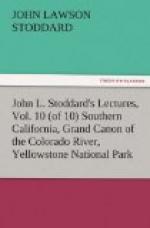[Illustration: PUEBLO WATER-CARRIERS.]
We lingered for some time upon this citadel of Acoma, profoundly interested in the life and customs of a people that asks no aid of the United States, but is, to-day, as self-supporting as it has always been. The number of Pueblo Indians was never very large. It is probable that there were in all about thirty thousand of them at the time of the Spanish conquest, in 1540, and there are now about one-third that number scattered through more than twenty settlements. In an arid land where the greatest need is water, it is not strange that the dwellers on these rocky eyries should be called in the Indian dialect “Drinkers of the dew,” for it would seem as if the dew must be their only beverage. But there are springs upon the neighboring plains whose precious liquid is brought up the steep trail daily on the heads of women, in three or five gallon jars, the carrying of which gives to the poise of the head and neck a native grace and elegance, as characteristic of Pueblo women as of the girls of Capri. Moreover, on the summit of the mesa there are, usually, hollows in the rock, partly natural, partly artificial, which serve as reservoirs to retain rain water and keep it fresh and cool.
[Illustration: AN ESTUFA.]
Besides the communal apartment-house, every pueblo contains two characteristic edifices. One is as ancient as the tribe itself and thoroughly aboriginal, the other is comparatively modern and bears the imprint of the Spaniard; they are the estufa and the Roman Catholic church. The estufa has always played a prominent part in the history of these Indians. It is a semi-subterranean council hall, where matters of public business are discussed by the chiefs. The government of the Pueblos is practically the same as when the Spanish found them. Each village seems to be completely independent of its neighbors, and no member of one tribe is allowed to sell real estate to members of another, or to marry into another clan without permission from his own. Each settlement is governed by a council, the members of which, including its chief, are chosen annually. Heredity counts for nothing among them, and official




